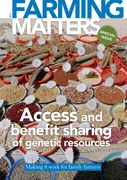Only a small number of governments have established meaningful and effective farmer-centred measures for the implementation of access and benefit sharing of genetic resources. One reason is the highly complex nature of the international regulatory system. This special issue of Farming Matters magazine presents practical ways in which access and benefit sharing for family farmers can be enhanced through collaborative efforts based on the rural realities, knowledge and needs of local communities. Key in this approach are community seed banks and farmer seed systems, which serve as local points of access to genetic resources as well as ensuring equitable sharing of benefits. This article presents an overview of both the ‘formal’ and ‘informal’ access and benefit sharing systems that are currently being used, and examines the theory and practice of these systems.
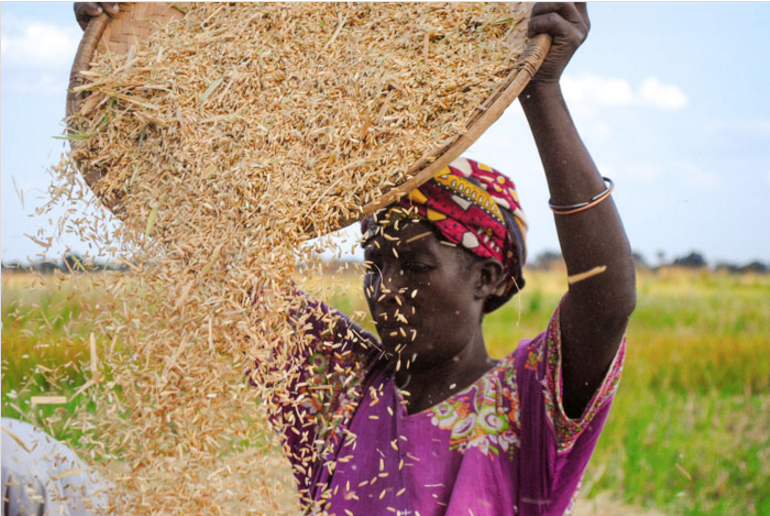
The web of biodiversity that the world’s food production depends on is comprised of thousands of species of crops with untold genetic variability. Since the emergence of farming systems 12,000 years ago the total sum of the world’s plant genetic resources for food and agriculture has vastly expanded. Farmers learned to save the seeds of crops they deemed the easiest to process or store, those that were most likely to survive in harsh growing seasons, or those that simply tasted best. As a result, more than 7,000 species of plants have been cultivated or collected up until the present day.
Many of these crops are important to local communities and family farmers, as a way to achieve food and nutrition security, enhance food sovereignty, preserve biodiversity, maintain cultures and build resilience to climate change and other forms of stress. Seed saving, exchanging, using and selling are a fundamental part of the cultural repertoire of rural communities, especially indigenous peoples. These are customary practices that go beyond national borders. As a result of generations of seed exchanges, peoples and countries have become interdependent as they all rely on genetic resources that have originated elsewhere for food security (1).However, genetic resources are disappearing at an alarming rate. Out of a total of 250,000 known plant species, approximately 7000 (as indicated above) have been used for human food since the origin of agriculture. Out of these, just 12 crop and five animal species provide three quarters of the world’s food today. Across the world, traditional seed diversity and related knowledge are no longer passed on, as farmers are encouraged or pressured to purchase seed.
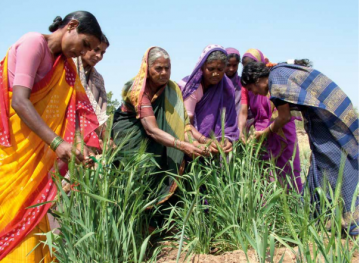
With the erosion of these resources, farmers and other actors in the food system loose the potential to adapt to new socio-economic and environmental conditions, such as population growth and climate change. Since the emergence of an international plant genetic resources regime in the early 1990s, established in response to these threats, ownership and access to plant species and the genetic potential they have has entered national and international agricultural, trade and environmental agendas. The most significant element of this process has been the debate on the definition and implementation of access and benefit sharing (ABS).
The formal access and benefit sharing regime
To date, only a relatively small number of national governments have tried to design and enact meaningful and effective measures to implement ABS for genetic resources that are clearly farmer-centred. While ABS implementation faces challenges, many institutions, organisations, indigenous peoples and other actors involved in genetic resources conservation are critical of the development of an overly formal ABS system. As this issue of Farming Matters demonstrates, the current system in place globally is considered to be too theoretical, proposed procedures are too bureaucratic and legalistic, and proposed measures are unsupportive of smallholder farming around the world.
The cases presented here also highlight that there are many practical ways in which access and benefit sharing is designed and implemented through collaborative efforts based on the rural realities, knowledge and needs of local communities and farming families. Community seed banks and other forms of seed exchange are effectively putting access and benefit-sharing into practice in a way that enhances the resilience and autonomy of food producers and their farming systems while preserving biodiversity.
The current ABS regime consists of a number of international agreements, the two most important being the Convention on Biological Diversity and the International Treaty on Plant Genetic Resources for Food and Agriculture. We summarise these agreements below.
The Convention on Biological Diversity (CBD)
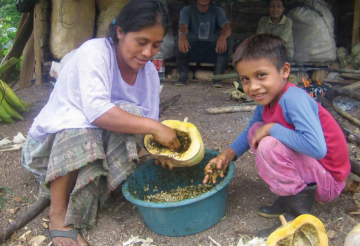
Negotiated under the auspices of the United Nations Environment Programme (UNEP), the Convention on Biological Diversity (CBD) entered into force on 29 December 1993. The Convention is legally binding, which means that states who signed it are obliged to implement its provisions. So far, 190 countries and the European Community have become members of the CBD. One of the three objectives of the Convention is the fair and equitable sharing of the benefits arising from the utilisation of genetic resources.
Protection of traditional knowledge: theory
Article 15 of the Convention provides a general framework for the implementation of access and benefit sharing arrangements. As states are considered to have sovereign rights over their biological resources, under the CBD they are the designated authority to determine who has access to genetic resources, and how. Access to genetic resources under the CBD must be based on the two principles. First, free prior informed consent which refers to the idea that the country of origin of the genetic resources (or the country that has acquired these resources under the Convention) has to obtain consent from the providing party- which can be an indigenous or local community- to allow third party use of these resources. Second, the terms of such access are to be ‘mutually agreed’.
A supplementary agreement to the CBD, the Nagoya Protocol on Access to Genetic Resources and the Fair and Equitable Sharing of Benefits Arising from their Utilization (2010), provides a legal framework for the effective implementation of benefit sharing. The Protocol was adopted in Japan and has been signed by 92 countries as of 2015. Throughout the Protocol state sovereignty (as in the CBD) overrules the rights of indigenous peoples and small scale farmers. Most notably, the language used in the Protocol creates a double standard between the rights of indigenous and local communities and those of state parties. The Nagoya Protocol Art. 5 requires that States obtain, under certain circumstances, the consent of the concerned communities (including family farmers) to allow another State access to their traditional knowledge, along with an agreement on a mechanism to share the benefits that may come from the use of that knowledge with the respective community. However, this is turning out to be highly problematic in practice.
Protection of traditional knowledge: practice
As the CBD throughout reaffirms national state sovereignty over genetic resources, there are serious challenges when it comes to protecting the human rights, cultural rights, and specifically indigenous rights of communities who are the custodians and users of genetic resources. Agriculture and food in particular have characteristics that do not fit into the logic of other types of transactions between state parties. One of the reasons for this discrepancy is that farmers and farming communities have exchanged their crops, and the genes within their crops, since the beginning of agriculture, regardless of states or borders. The CBD leaves no space for these transactions. To date, customary laws can only be recognised under the Protocol when these are ‘in accordance with domestic law’, which is not the case in many countries. Moreover, free prior and informed consent is not embedded in national law in the majority of countries, and where it is, implementation is often problematic.
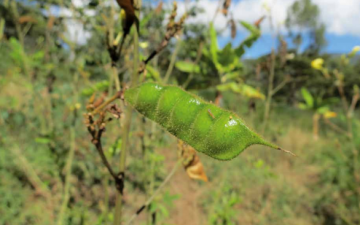
Hence, a lack of power to make use of domestic law, if it is available at all, undermines the rights of indigenous and farming communities to secure benefits from ABS under the CBD. Other than this specific and poorly defined requirement of consent, the CBD and its Nagoya Protocol do not address or even mention Farmers’ Rights (see below).
The Multilateral System of the International Treaty on Plant Genetic Resources for Food and Agriculture (ITPGRFA)
In the context of global interdependence on plant genetic resources for food and agriculture and in reaction to the state sovereignty-based CBD, a global Multilateral System (MLS) was created in 2001 with the International Treaty on Plant Genetic Resources for Food and Agriculture (ITPGRFA). The International Treaty on Plant Genetic Resources for Food and Agriculture (ITPGRFA, or ‘the Treaty’) aims to contribute to food security with three specific objectives: the conservation of plant genetic resources; their sustainable use; and the sharing of benefits that are derived from the use of plant genetic resources with the countries where they originated. The Treaty recognises both the necessity of ex situ conservation (through seed banks) and in situ conservation (through on-farm cultivation of rare and traditional varieties) in order to reverse the loss of crop genetic diversity.
Farmers have exchanged their seeds since the beginning of agriculture, regardless of states or borders
The Treaty establishes a system for access and benefit sharing for 64 plant genetic resources for food and agriculture, listed in ‘Annex I’ of the ITPGRFA and selected for their relevance for food security. The logic underpinning the MLS is that it enables these resources to be treated as ‘pooled goods’ without individual owners with whom individual contracts for access and benefit-sharing must be negotiated (as is the case under the CBD). As such, in the MLS benefits resulting from their use do not go back to the provider (one single country) but must be shared with all other states through a multilateral fund. Facilitated access to genetic resources that are included in the MLS is, itself, recognised as a major benefit arising from the use of genetic resources. Other benefits that are to be shared on a ‘fair and equitable’ basis include the exchange of information, access to and transfer of technology, capacity building and the sharing of monetary and other benefits arising from commercialisation.
The resources in the MLS are available to anyone who wants them under a standard contract, i.e. the Standard Material Transfer Agreement. Monetary benefits from these agreements do not flow from users to providers (as in the CBD) but into a multilateral fund – the Benefit Sharing Fund. This fund is also open to direct contributions from the contracting parties, the private sector, non-governmental organisations and others. However, to date no mandatory payment has been made to the Benefit Sharing Fund.
As of 2015, 136 countries have acceded the Treaty, which means they have to ensure the conformity of national laws, regulations and procedures with their obligations under the Treaty.
Farmers’ Rights
The Treaty Article (9.2) on Farmers’ Rights recognises the enormous contribution that farmers and their communities have made and continue to make to the conservation and development of plant genetic resources. The Article includes the protection of traditional knowledge, and the right to participate equitably in benefit sharing and in national decision making about plant genetic resources. It gives governments the responsibility for implementing these rights.
Treaty Article 9.2 stipulates that: “The Contracting Parties agree that the responsibility for realising Farmers’ Rights, as they relate to PGRFA, rests with national governments. In accordance with their needs and priorities, each Contracting Party should, as appropriate, and subject to its national legislation, take measures to protect and promote Farmers’ Rights, including:
- (a) protection of traditional knowledge relevant to plant genetic resources for food and agriculture;
- (b) the right to equitably participate in sharing bene ts arising from the utilization of plant genetic resources for food and agriculture; and
- (c) the right to participate in making decisions, at the national level, on matters related to the conserva- tion and sustainable use of plant genetic resources for food and agriculture.”
The decision whether or not to embed these Farmers’ Rights in national law rests with goverments
The decision whether or not to embed these Farmers’ Rights in national law (in particular trade related aspects of intellectual property rights such as UPOV), however, rests with national governments. This process has proven to be dif cult and costly, especially in developing countries where there often is a lack of capacity, expertise, resources and sometimes, political will. Farmer-centred policy measures and legislation exist in a number of countries, such as India and Nepal, as illustrated and discussed in the article ‘Lessons for access and benefit sharing from community seed banks in India’ , but remain problematic. (6) In addition, patents or breeders’ rights may restrict or even prohibit farmers’ access.
The ‘formal’ ABS regime in a deadlock
In summary, progress in the domestic implementation of ABS has been considerably slower than expected, partially due to the difficulties of the complex interface between these two systems: the Convention on Biological Diversity and the International Treaty on Plant Genetic Resources for Food and Agriculture. Combined with the system’s bureaucracy and the lack Farmers’ Rights recognition in national law, family farmers have been able to benefit little from the ‘formal’ system. In addition, agreements on trade related aspects of intellectual property rights also influence the system, limiting the legal space for small farmers and indigenous communities.
At the same time, it should be stressed that access and benefit sharing still is an intrinsic element of the customary community seed saving and exchange initiatives among family farmers and indigenous communities. The following section takes a closer look at these, and the second half of this publication presents three specific case studies.
Access and benefit sharing in community seed banks
Community seed banks store and manage seeds with the aim of providing community members with seeds to use. As such, they are usually part of farmers’ informal seed systems, in which the various stages of seed management—selection, conservation, exchange and improvement—take place without involvement of or control by research, development or government agencies. As some presented experiences demonstrate, community seed banks can be an effective way to improve access and benefit sharing of important crop diversity. Community seed banks also function as a mechanism to implement farmers’ or indigenous rights, by way of recognition, participation in decision making, benefit sharing and a supportive policy and seed regulatory framework. This approach is highlighted in a several case studies in this publication:Lessons for access and benefit sharing from community seeds bank in India and Access and benefit sharing for family farmers in Zimbabwe.
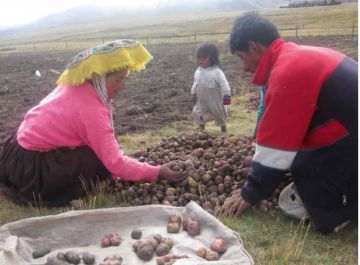
Community seed bank practices and participatory plant breeding activities build on the existing and mostly informal forms of access and benefit sharing while adding new elements. They are sometimes engaged in participatory plant breeding and variety selection, which can strengthen access to and availability of improved seeds and increase diversity. In participatory plant breeding , farmers, researchers, local consumers and other actors join forces in a continuous, highly dynamic and complex process of selection and exchange of seeds, interactions between farmers and seed producers , research institutions and, sometimes, with agricultural and health authorities and government officials (see Ecuador case). Benefits are generated throughout the process of collaboration and are shared dynamically and at all times among the diverse actors (see The Netherlands case). Usually started on a small scale, some of these crop improvement practices have evolved into seed production and the sale of new varieties, such as maize in China (see China case ). Usually, local seed production focuses on the crops and varieties that the commercial seed sector does not offer. This kind of activity can contribute to the financing of operations of community seed banks and thus enhance their viability in the long term. Community seed banks thus serve as key local sources and access points of germplasm, allowing farming communities to exchange seeds in a decentralized manner through social networks and organized events, such as diversity fairs and participatory seed exchanges.
Community seed banks sometimes also serve to open up policy space for national ABS regulation. In Nepal, for example, ten seed banks functioned as the designated local institutions to assess whether to provide Prior Informed Consent to bio-prospectors. This was a way to implement the PIC provisions of the Agrobiodiversity Policy of 2007 and the draft ABS Law of 2003. In the Brazilian state of Paraíba a law was approved to legalise the distribution of seeds produced by community seed banks without the formal certification by specialised agencies normally required (see Brazil case). In India, researchers are proposing that village-based seed banks become an integral part of the government’s national seed policies (see India case).
In sum, rather than fulfilling international obligations or legal frameworks, community seed bank systems are embedded in traditional and cultural practices in many different specific circumstances. Concepts of distributive justice, reciprocity and equity are criteria that guide how benefits from the management and use of land and other resources are shared among community members. Fundamentally, these are the principles that make community seed systems effective for family farmers.
This brings into focus questions such as: What are the main success factors and challenges of both formal and informal ABS-systems for family farmers? What lessons can be drawn from existing practices? What effective solutions can we develop to make the procedures less bureaucratic and legalistic, while truly enhancing access and benefit sharing for family farmers? Taking experiences from around the world as a starting point, this issue of Farming Matters explores potential answers to these questions.
Notes
1 Koutouki, K. (2011), Nagoya Protocol: Status of Indigenous and Local Communities. Legal Aspects of Sustainable Natural Resources Legal Working Paper Series.
2 Bioversity International (2014), Bioversity International’s 10-year strategy 2014–2024.
3 UN FAO (2010), State of the world’s plant genetic resources for food and agriculture.
4 ‘Regime’ is commonly understood as a system or method of government (Cambridge Dictionary)
5 Ker, C. Loua . S., Sanou, M. (2013), Building a Global Infor- mation System in Support of the International Treaty on Plant Genetic Resources for Food and Agriculture. In: Crop Genetic Resources as a Global Commons: Challenges in International Law and Governance. (Halewood, M., López Noriega, I, Loua , S. eds). Routledge pp. 283-309.
6 See e.g.: Shrestha, P., Vernooy, R., Chaudhary, P. (eds. 2012), Community Seed Banks in Nepal: Past, present, future. Pro- ceedings of a National Workshop, 14-15 June 2012, Pokhara, Nepal.
7 Adapted from: Vernooy, R., Sthapit, B., Galluzzi, G. and Shrestha, P. (2014), The Multiple Functions and Services of Community Seed banks. In: Resources 2014:3, pp. 636-656.
8 Vernooy, R. (2003), Seeds That Give: Participatory Plant Breed- ing. International Development Research Centre. Ottawa, Canada.
9 Shrestha, P., Vernooy, R., Chaudhary, P. (eds. 2012), Commu- nity Seed Banks in Nepal: Past, present, future. Proceedings of a National Workshop, 14-15 June 2012, Pokhara, Nepal.
Robin Pistorius (pistorius@facts-of-life.nl) is an independent consultant and guest lecturer at the University of Amsterdam, The Netherlands.

